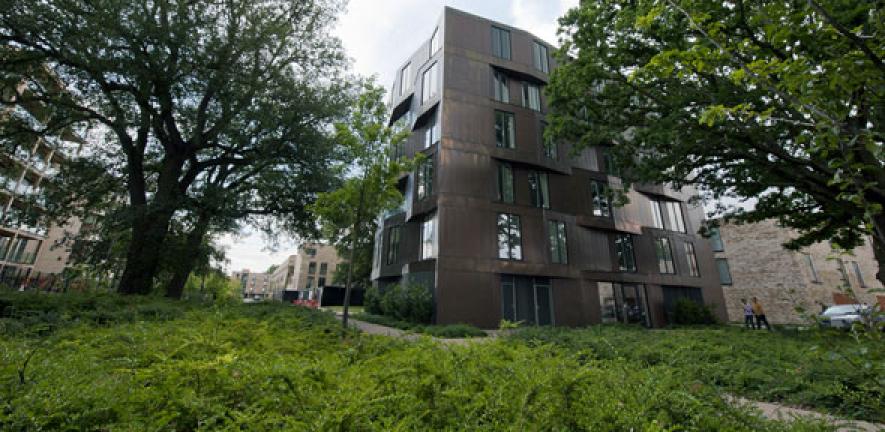
Life in towns and cities can grind you down, but putting health and wellbeing at the centre of new housing and infrastructure developments could make for happier, healthier citizens.
Life in towns and cities can grind you down, but putting health and wellbeing at the centre of new housing and infrastructure developments could make for happier, healthier citizens.
When new infrastructure integrates opportunities for walking and cycling, we see people shifting their commuting behaviour
David Ogilvie
“When a man is tired of London, he is tired of life; for there is in London all that life can afford,” said Samuel Johnson in the 18th century. For Johnson, the rich tapestry of London life and the myriad cultural assets clearly outweighed any downsides of city dwelling.
For others, though, city life is a grind. Public transport is overcrowded, house prices are soaring, traffic is at gridlock and diesel fumes hang almost perceptibly in the air. Little surprise, then, that people do become tired of London, even if not of life itself.
Even if issues such as air pollution are taken out of the equation, living in a city can be bad for your health, which is not good news considering that the World Health Organization estimates that by 2017 the majority of people will be living in urban areas.
A study published in 2014 by Dr Manjinder Sandhu from the Department of Medicine suggested that increasing urbanisation of rural areas in sub-Saharan Africa might lead to an explosion of the incidence of stroke, heart disease and diabetes. Yes, moving to towns and cities provides better access to education, electricity and hospitals, but town and city dwellers become less active, their work becomes less physical and their diets worsen.
“If this pattern is repeated across the globe – which we think it will – then we could face an epidemic of obesity, diabetes and other potentially preventable diseases,” says Sandhu. “Local and national governments need to take this into consideration when planning infrastructure to try and mitigate such negative effects.”
As far as ‘healthy’ cities go, Cambridge has a lot going for it. Its population has higher than average levels of education and is physically active: Cambridge has been nicknamed ‘the cycling capital of Britain’ – the sight of bicycles leaning against walls is as iconic as that of punts passing under the Bridge of Sighs. But as the city expands and house prices rocket, more and more people are living in neighbouring villages and towns, where cycling to work along winding, congested country lanes can be less appealing than driving.
In 2011, the world’s longest guided busway opened, connecting Cambridge with nearby Huntingdon and St Ives along a former railway line. An integral part of the busway was a cycle path along its route – and this appears to have helped nudge people in the right direction. A study led by Dr David Ogilvie from the Medical Research Council (MRC) Epidemiology Unit found that, among people who commuted into Cambridge from within a 30 km radius, those who lived closer to the busway were more likely to increase the amount of ‘active’ commuting they did, particularly cycling.
“Commuting is a part of everyday life where people could include a bit more physical activity without having to think about it very much or make time for it,” says Ogilvie. “When new infrastructure integrates opportunities for walking and cycling, we see people shifting their commuting behaviour.”
Ogilvie’s research is, he says, “contributing bricks of evidence to a wall that’s slowly being assembled from across the world of the health benefits of investing into this kind of infrastructure.” While such benefits are often alluded to in business cases, until now the evidence to support them has been limited.
There are ways to integrate more pedestrian-friendly environments in existing infrastructure, he says, citing examples such as those in the Netherlands – now being introduced in some areas of London – where traffic is slowed to walking pace and the divisions between pavement and road are deliberately blurred, cuing drivers to share the space.
With more thoughtful urban planning, Ogilvie says, it should be possible to design towns and cities as environments that promote not just physical activity, but improved health and wellbeing – “in short, a place where people want to live”.
“Sprawling cities with retail parks on the fringes are not conducive to doing your shopping on foot,” he says. “People are more likely to walk and cycle around their neighbourhood if it is safe, well connected and has good local amenities. And getting people out on the streets not only gets them active, it also increases social interactions and a sense that it’s safe to be on the streets.”
Dr Jamie Anderson from the Department of Architecture is also interested in the relationship between the built environment and our broader wellbeing. As part of his PhD project with Professor Koen Steemers (Architecture) and Professor Felicia Huppert (Department of Psychology), he did a study of another Cambridge initiative, the housing development known as Accordia.
Since the first residents moved into their homes in the mid-noughties, Accordia has won numerous prizes, including the Royal Institute of British Architects Stirling Prize, for its innovative mixing of private and public spaces. Yet surprisingly, says Anderson, no one had done a detailed study of the impact on its residents.
One of the interesting approaches taken by Accordia was to focus on communal spaces rather than private gardens: only one in five homes has its own garden. Given the stereotype of the British as a very private people, how did people respond? Did people spend time chatting outdoors with their neighbours, or did they shut themselves away and draw the curtains?
The results, explains Anderson, were mixed. While one middle-aged couple missed having their own garden and were now on a long waiting list for a local allotment, one mother described the communal gardens as “crucially important”: she had suffered from postnatal depression and, with her husband away at work all day, she told Anderson that she “wouldn’t have got through her depression” without the interactions that the adjacent communal areas provided.
“In terms of behaviours that we associate with physical health and positive mental health – so people interacting with each other, children out playing, for example – we found clear positive associations with Accordia’s outdoor neighbourhood spaces,” he adds, “but when we looked at people’s subjective wellbeing, it wasn’t as clear cut.”
With Accordia, Anderson was evaluating an already established development, but he now has a chance to influence a project at the planning stage. Part of the Chancellor of the Exchequer’s vision of a ‘Northern Powerhouse’ will see a £110 million culture venue in Manchester named The Factory after the eponymous record company behind such iconic bands as Joy Division and Happy Mondays.
Under a fellowship from the Engineering and Physical Sciences Research Council, Anderson, in collaboration with engineering firm BuroHappold, is carrying out a Health Impact Assessment (HIA) of the proposed new site, looking at factors that might influence health and wellbeing, from the lighting in office spaces, through to educational opportunities for young people from deprived communities and the restaurants within the venue.
HIAs are currently voluntary, but are set to become mandatory for significant developments across the UK in 2017, and can help architects and designers improve their submissions for planning application. How effective they’ll be is unclear, warns Anderson. “You might have some really strong evidence, but the final decision is a blend of opinion from various stakeholders, so you could end up with a watered-down version of what’s needed.”
He remains optimistic, however: “We’re moving in the right direction. By building consideration of health and wellbeing into the planning process, it should raise the bar and hopefully we will see many more cycle lanes, more inviting and better options for active transport, and maybe fewer fast-food shops.”
“I don’t know what makes me stay / The city life just ain’t the same,” sang New Order, one of Factory Record’s best known signings, in 2001. Perhaps the work of Cambridge researchers will help make cities attractive – and healthy – places to stay.

The text in this work is licensed under a Creative Commons Attribution 4.0 International License. For image use please see separate credits above.




